Lifestyle
Roman era mosaic panel with erotic theme that was stolen during World War II returns to Pompeii
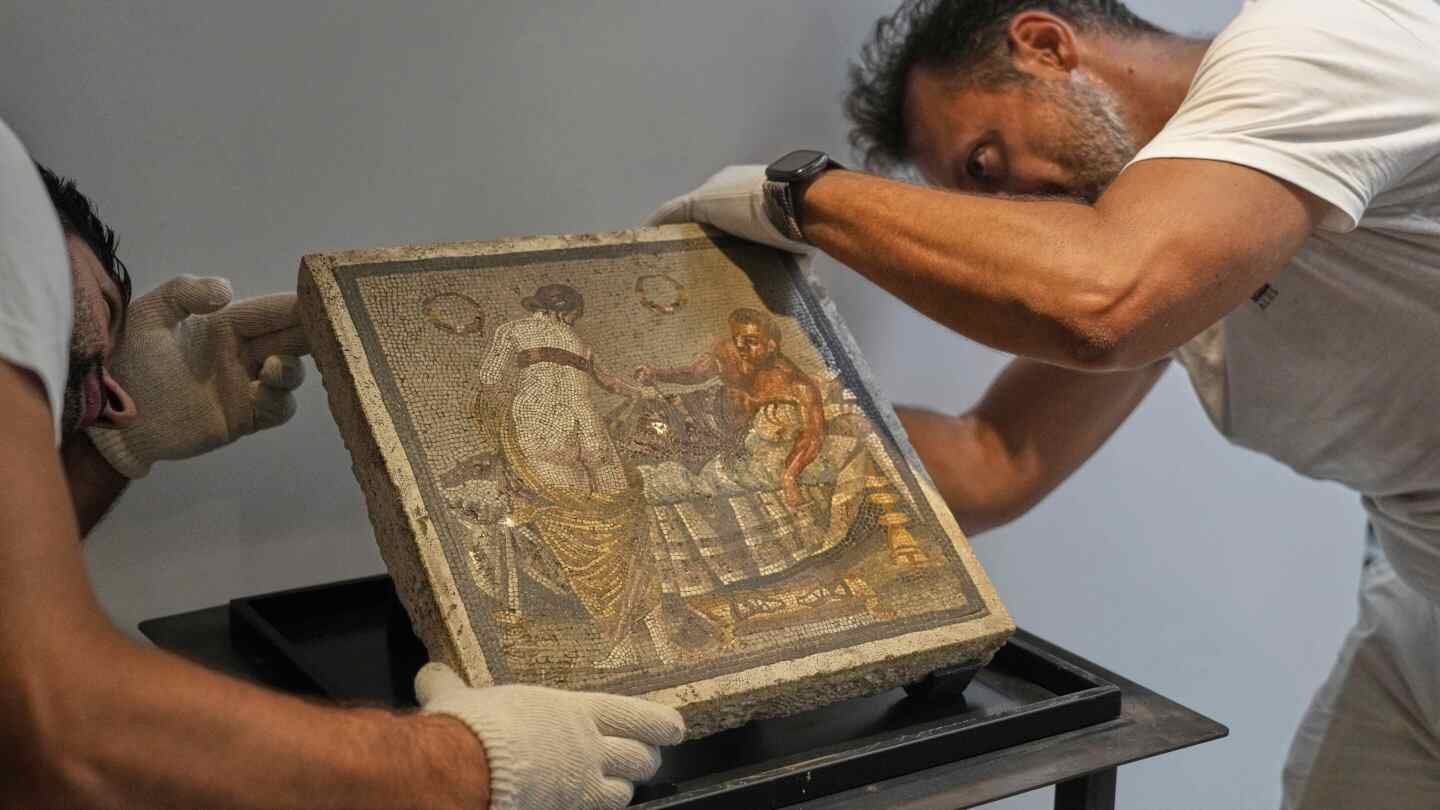
POMPEII, Italy (AP) — A mosaic panel on travertine slabs, depicting an erotic theme from the Roman era, was returned to the archaeological park of Pompeii on Tuesday, after being stolen by a Nazi German captain during World War II.
The artwork was repatriated from Germany through diplomatic channels, arranged by the Italian Consulate in Stuttgart, Germany, after having been returned from the heirs of the last owner, a deceased German citizen.
The owner had received the mosaic as a gift from a Wehrmacht captain, assigned to the military supply chain in Italy during the war.
The mosaic — dating between mid- to last century B.C. and the first century — is considered a work of “extraordinary cultural interest,” experts said.
“It is the moment when the theme of domestic love becomes an artistic subject,” said Gabriel Zuchtriegel, director of the Archaeological Park of Pompeii and co-author of an essay dedicated to the returned work. “While the Hellenistic period, from the fourth to the first century B.C., exulted the passion of mythological and heroic figures, now we see a new theme.”
The heirs of the mosaic’s last owner in Germany contacted the Carabinieri unit in Rome that’s dedicated to protecting cultural heritage, which was in charge of the investigation, asking for information on how to return the mosaic to the Italian state. Authorities carried out the necessary checks to establish its authenticity and provenance, and then worked to repatriate the mosaic in September 2023.
The collaboration with the Archaeological Park of Pompeii was also key, as it made it possible to trace it to near the Mount Vesuvius volcano, despite the scarcity of data on the original context of its discovery, the Carabinieri said.
The panel was then assigned to the Archaeological Park of Pompeii where, suitably catalogued, it will be protected and available for educational and research purposes.
“Today’s return is like healing an open wound,” Zuchtriegel said, adding that the mosaic allows to reconstruct the story of that period, the first century A.D., before Pompeii was destroyed by the Vesuvius eruption in A.D. 79.
The park’s director also highlighted how the return by the heirs of its owner signals an important change in “mentality,” as “the sense of possession (of stolen art) becomes a heavy burden.”
“We see that often in the many letters we receive from people who may have stolen just a stone, to bring home a piece of Pompeii,” Zuchtriegel said.
He recalled the so-called “Pompeii curse,” which according to a popular superstition hits whoever steals artifacts in Pompeii.
The world-known legend suggests that those who steal finds from the ancient city of Pompeii will experience bad luck or misfortune. That has been fueled over the years by several tourists who return stolen items, claiming they brought them bad luck and caused tragic events.
Lifestyle
US air travel may nearing a new era after Kristi Noem hints changes
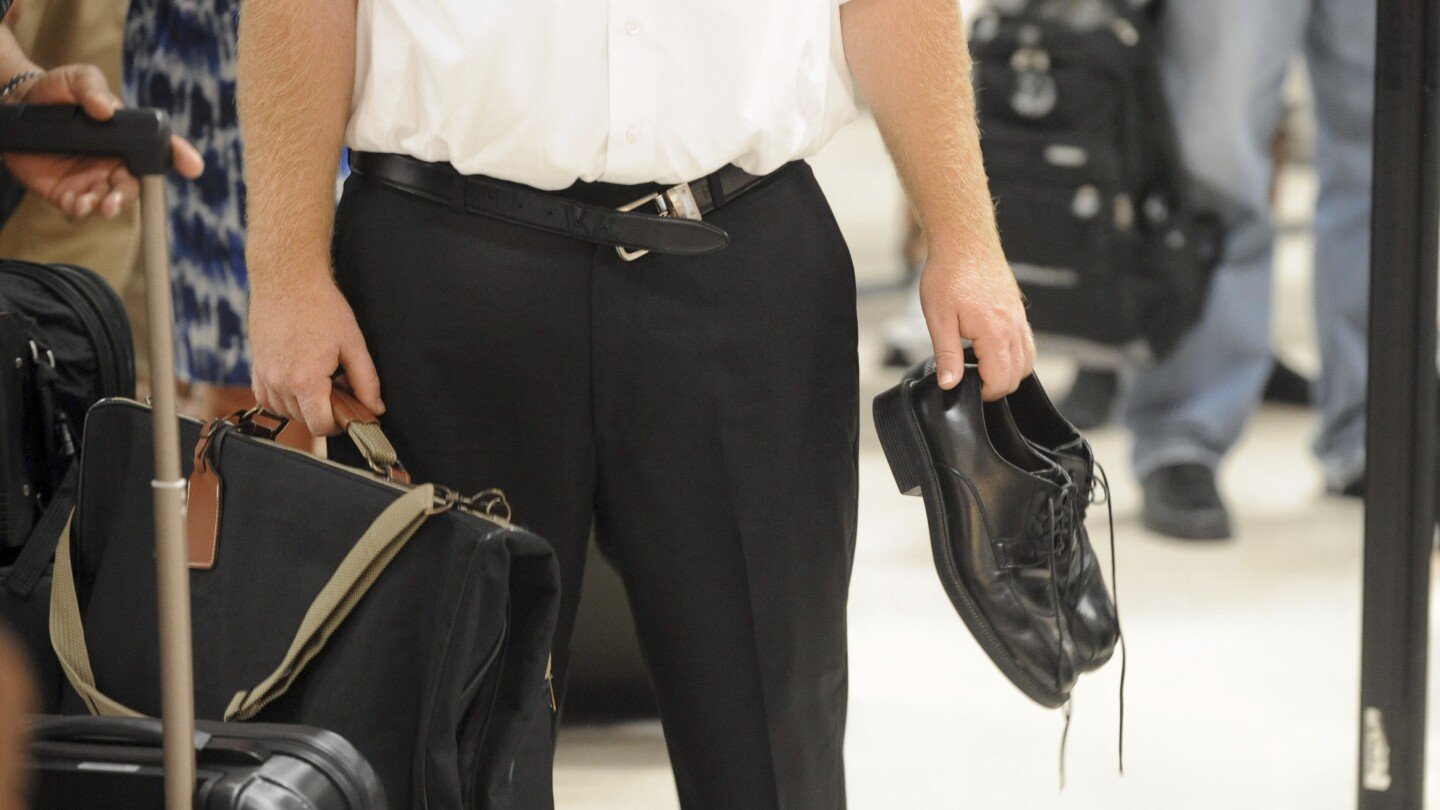
NEW YORK (AP) — When limits on liquids were introduced at TSA checkpoints across the country in 2006, bins overflowed with bottled water, toothpaste, shaving cream and so much more. Nearly two decades later, travelers are much more accustomed to the “3-1-1” regulations” governing the size of the liquids they’re flying with, but scenes of passengers guzzling a beverage before putting their bags through the screening machines are still common.
That’s why Homeland Security Secretary Kristi Noem sent ripples through the traveling public when she said earlier this week that changes might be afoot when it comes to the TSA’s current liquid limits.
“The liquids, I’m questioning. So that may be the next big announcement, is what size your liquids need to be,” Noem told a conference in Washington.
Will travelers be able to carry bigger bottles? Multiple 1-quart bags of liquids? Those details haven’t been rolled out. But coming on top of her announcement earlier this month that travelers could keep their shoes on at TSA checkpoints, it seems a much different security experience for American air travelers might be emerging.
9/11 and its aftermath changed much
Airline travel changed dramatically after the Sept. 11, 2001 attacks. Before that, airlines were responsible for security and would often contract it out to private firms, said Henry Harteveldt, an airline industry analyst with Atmosphere Research Group. Travelers often didn’t need to show their ID at security checkpoints — and people without boarding passes, such as family members or friends, could go to the gate in some locations.
“It was much more casual. And clearly it was ineffective, because 9/11 occurred,” Hartevelt said.
That’s when the Department of Homeland Security and the Transportation Security Administration were born, with the mandate of preventing more terrorist attacks.
The liquid limits, however, didn’t kick in until 2006, after authorities foiled a plot that used liquid explosives smuggled aboard carry-on luggage. The TSA then very briefly banned all liquids in carry-on luggage. That ban lasted about six weeks, but strained airlines’ baggage systems as more and more travelers turned to checked bags to pack toiletries.
At the time the 3.4-ounce limit was implemented, the FBI and other laboratories had found that tiny amounts of substances small enough to fit into a quart-size bag couldn’t blow up an airliner.
When the ban was eventually lifted in September 2006, consumers and businesses alike had to learn how to adapt to the 3-1-1 rule — leading to more demand for smaller, travel size bottles of anything from shampoo to toothpaste, as well as clear, “TSA approved” toiletry bags that are still seen on store shelves today.
The rule was also adopted in many countries around the world starting later that year.
Keith Jeffries, a former TSA director at Los Angeles International Airport and now vice president of K2 Security Screening Group, says whatever comes next needs to be clear for passengers. And he knows whereof he speaks.
Jeffries was working for TSA in Albuquerque, New Mexico, when the liquids rules came down overnight. Signage had to be changed to let passengers know of the new regulations. Barrels overflowing with toothpaste, shaving cream and shampoo had to be emptied every half hour. Jeffries remembers seeing a pair of shoes sitting in one of the barrels.
When he asked why, a TSA staffer said there was gel in the soles. “I said, ‘Please tell me I don’t have a passenger back there walking in the sterile area barefoot. And he says, ‘No, sir, they still have their socks on,’” he said. “That’s how chaotic it was.”
It’s about more than convenience
Any move to simplify the screening process and cut down on the time it takes for passengers to navigate checkpoints would be a welcome change for everyone, Harteveldt says. Because it isn’t just about convenience; those lines before the security checkpoints are the most at risk to a potential threat.
The fact that the TSA felt confident enough to change its shoe policy earlier this month may not save too much time from an individual traveler’s perspective, Harteveldt notes — but marks a “big step forward” toward cutting down the average length of the security process when you think about the number of people going through U.S. airports each day. Relaxing current liquid restrictions could aid that effort.
Still, questions remain. “What we don’t know is what the secretary is going to announce about liquids,” Harteveldt said. “Will they remove the liquid ban altogether — and can we go back to bringing full-sized of toiletries and other items with us? Will they allow people to bring more than one bag of toiletries and liquids? And importantly, will they relax the limit on (the) quart-size bag itself?’”
It’s also possible that the changes the TSA makes, whatever they are, only start at a handful of airports that have the technology to do so. Over the years, airports worldwide have adopted some aspects of security screenings faster or differently than others.
But travelers could be confused if they’re able to bring a full-size bottle of shampoo or lotion when flying out of one airport, for example, but not on their return trip home.
“The devil is going to be in the details,” Harteveldt said. “That’s why the rollout plan will be absolutely critical.”
Harveldt says a more streamlined process could make travelers less stressed, but others — including flight attendants and pilots who are in the skies more frequently — may object and question whether airport security is being compromised. Still, Harveldt says he doesn’t believe the TSA would make this change if the agency “didn’t feel it was authentically, truly safe.”
What of expedited security lines?
If shoe regulations disappear and liquid restrictions are eased, the effects could ripple into the TSA PreCheck program, in which passengers submit information like their fingerprints and the agency prescreens them for any red flags. By giving the agency this information, the traveler then gets some benefits not available to other travelers — a special line to go through and the ability to keep their computers in their bags and their shoes on, for example.
But if those benefits become more widely available to all passengers, will fewer people sign up for PreCheck?
“What is the impact on now both shoes and liquids going to have on TSA PreCheck enrollment? That is the million-dollar question,” Jeffries said. “And if I was still with TSA, I would be watching that closely over the next 12 to 18 months.”
While the prospect of increasing the current liquid limit could be a welcome change for many U.S. travelers, some experts say that the tech isn’t available in enough airports yet. Current X-ray machines used at most airports today have a difficult time distinguishing between different types of liquids, says Jeffrey Price, a professor of aviation at Metropolitan State University of Denver.
That’s key, he explains, in determining whether something is harmless or potentially explosive.
While newer computed tomography scanners are better and have begun making their way to airports, Price said in commentary published last week that it could take “another decade or more” before the newer machines are deployed at all U.S. airports.
“This is an issue that needs to be studied much more carefully than the policy to leave your shoes on,” he said in an email Thursday.
___
Associated Press editor Elaine Kurtenbach in Bangkok contributed to this report.
Lifestyle
Trump says Coke will shift to cane sugar. But increasingly, shoppers want no sugar in their sodas
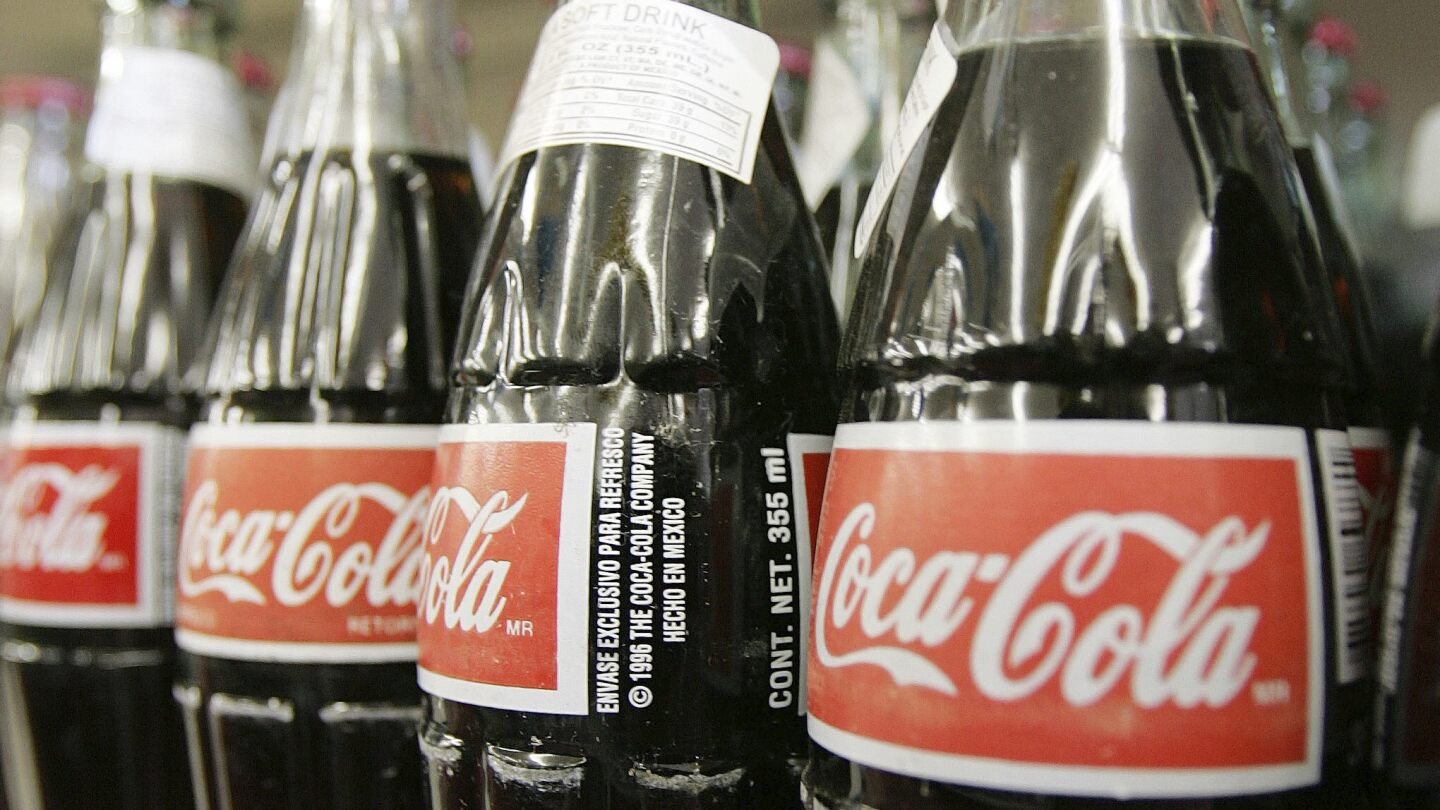
The debate over whether Coca-Cola should use high-fructose corn syrup or cane sugar in its signature soda obscures an important fact: Consumers are increasingly looking for Coke with no sugar at all.
Coca-Cola Zero Sugar, which was introduced in 2017, uses both the artificial sweetener aspartame and the natural sweetener stevia in its recipe. It’s one of Coke’s fastest-growing products, with global case volumes up 14% in the first quarter of the year. By comparison, the company’s total case volumes were up 2%.
PepsiCo also noted Thursday that 60% of its sales volumes in major markets in the second quarter came from low- or no-sugar drinks.
“When you look at colas, the percentage of growth coming from zero sugar is significant,” said Duane Stanford, the editor and publisher of Beverage Digest.
Coca-Cola Co. hasn’t confirmed a presidential pronouncement
The scrutiny over Coke’s sweeteners began Wednesday, when President Donald Trump announced that Atlanta-based Coca-Cola Co. had agreed to switch to using cane sugar in the regular version of its beverage manufactured in the U.S.
“I have been speaking to Coca-Cola about using REAL Cane Sugar in Coke in the United States, and they have agreed to do so,” Trump wrote on his social media site. “I’d like to thank all of those in authority at Coca-Cola. This will be a very good move by them — You’ll see. It’s just better!”
Coca-Cola didn’t confirm the change. In a statement, the company said it appreciated Trump’s enthusiasm and would share details on new offerings soon.
Stanford said he doubts Coca-Cola will fully shift away from high fructose corn syrup, which has sweetened Coke in the U.S. since the 1980s. There would be tremendous supply chain and logistics headaches, he said, and the U.S. doesn’t make enough sugar for Coke’s needs.
He expects the Atlanta-based company will offer a cane sugar-sweetened version in the U.S. just like its rival Pepsi has been doing since 2009. He noted that Coke has indulged U.S. fans by importing Mexican Coke, which is made with cane sugar, since 2005. Coke positions Mexican Coke as an upscale alternative and sells it in glass bottles.
A rush to defend high fructose corn syrup
The corn industry wasn’t happy with the speculation. In a statement Wednesday, Corn Refiners Association President and CEO John Bode said replacing high fructose corn syrup with cane sugar makes no sense and would cost thousands of American manufacturing jobs.
Shares in ADM, a maker of high fructose corn syrup, dipped nearly 2% Thursday after Trump’s announcement.
In a message on X, Coca-Cola defended high fructose corn syrup, saying it’s no more likely to contribute to obesity than table sugar or other full-calorie sweeteners.
“It’s safe; it has about the same number of calories per serving as table sugar and is metabolized in a similar way by your body,” the company said. “Please be assured that Coca-Cola brand soft drinks do not contain any harmful substances.”
The Food and Drug Administration also says there is no evidence of any difference in safety among foods sweetened with high fructose corn syrup and those that sugar, honey or other traditional sweeteners.
US consumers are seeking more options
Soft drink preferences are highly subjective, as anyone who has been in a Pepsi vs. Coke or 7-Up vs. Sprite debate knows. But recent trends indicate that Coke and other drink makers need to focus on the kinds of low- and no-sugar drinks that a growing number of consumers are seeking, according to Stanford.
He said his data shows original Coke was the top seller by volume in the U.S. last year, with 19% market share, while Coke Zero Sugar was seventh and had a 4% market share. But Coke Zero Sugar’s share grew 10%, while original Coke’s share was flat.
Paige Leyden, the associate director of food service, flavors and ingredients reports at the market research company Mintel, said drinks with a health halo like Olipop — which has 1 gram of sugars compared to original Coke’s 65 grams — are also pressuring legacy soda makers. Mintel expects full-sugar sodas will see a 3.4% rise in U.S. sales this year, while diet sodas will see 11.8% growth.
Still, nutritionists suggest avoiding added sugars, no matter the form, since they provide empty calories with no nutrients. The 2020 U.S. dietary guidelines advise people to limit foods and beverages higher in added sugars, and say children under 2 should not be fed them at all.
Health Secretary Robert F. Kennedy, whose nutrition views often diverge from mainstream nutrition science, has spoken out against sugar. His agency is expected to release updated nutrition guidelines later this year.
“There’s things we’ll never be able to eliminate, like sugar,” Kennedy said at an April news conference. “And sugar is poison, and Americans need to know that.”
Aspartame and other artificial sweeteners are also named as a concern in a government report Kennedy issued in May.
___
AP Health and Science Editor Jonathan Poet contributed from Philadelphia.
Lifestyle
How to survive and thrive on a family road trip
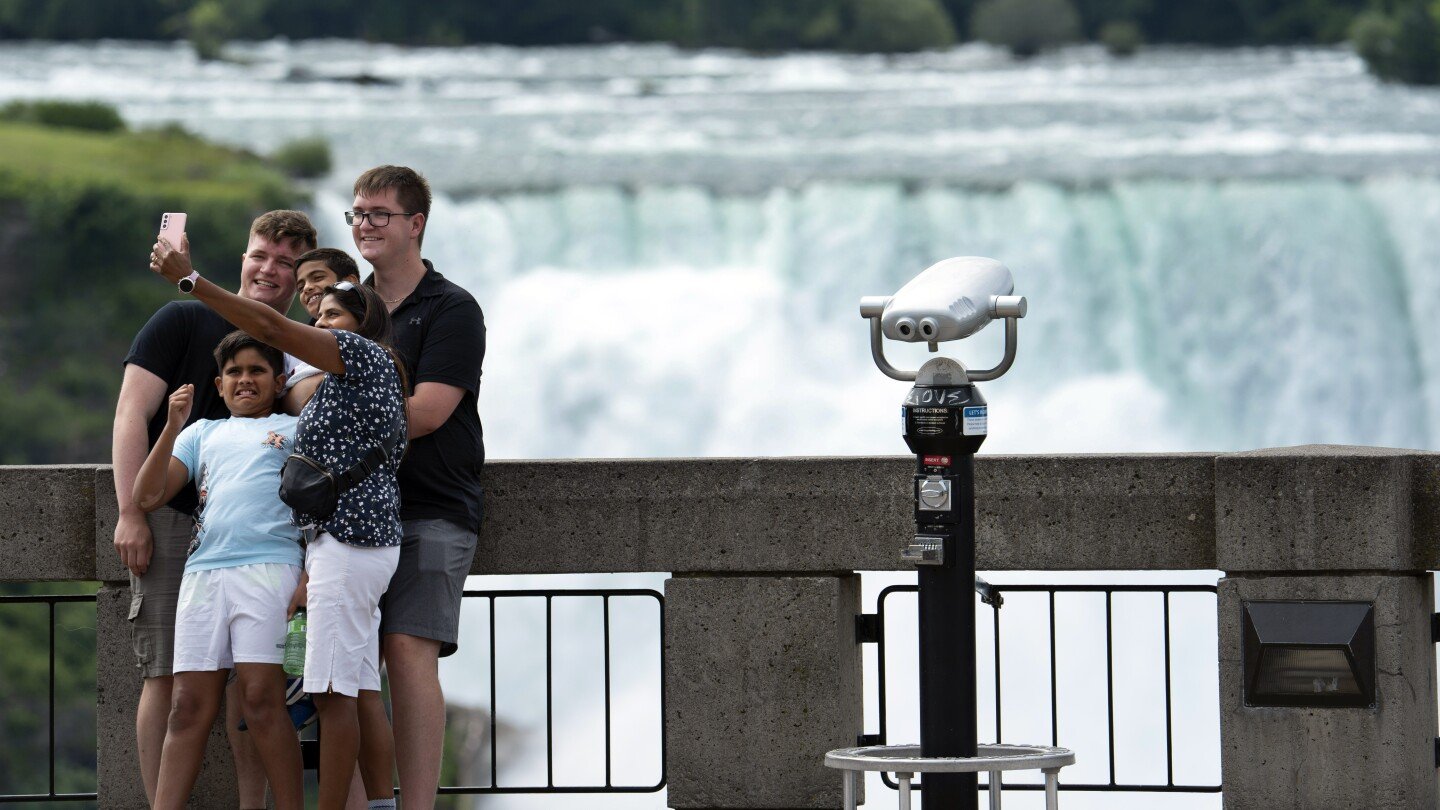
If you’re going to be road-tripping with your family this summer, get ready to embrace unexpected moments of both connection and inevitable chaos.
I found both when I packed up the car with my husband and two kids — one of them a teenager — for the eight-hour drive from Boston to Niagara Falls. We had taken long road trips as a family in the past, but our kids, now 8 and 14, were older. My son, firmly in his “closed-door, don’t talk to me” phase, wasn’t exactly thrilled about spending over 460 miles trapped in our smallish Nissan Rogue. We also live in a part of the country where we don’t spend much time in cars in our everyday life.
How would we all manage the close quarters?
Here’s some of what I learned — along with advice from the experts — about not only surviving a family road trip but having a good time:
First, why do it?
Many road-trip veterans cite the chance to bond and create family memories. Eighteen-year-old Samara Worsham, for example, spent 30 days crossing 25 states with her family in 2022. Now preparing to leave for college, she says she cherishes that time on the road.
“There were long stretches with no cellular data, leaving us nothing to do but talk,” she said.
Along with visiting U.S. landmarks, Worsham’s fondest memories include hotel pool swims with her siblings, and her father’s mission to sample every fast-food chain across the country.
There are practical advantages to the family car trip too.
“It’s more economical than flying, especially with a big family,” says Jamie Davis Smith, a lawyer and writer from Washington, D.C., who takes a road trip every year with her husband and children. “Plus, you don’t have to rent a car at the destination.”
Get family input on the itinerary
Alain Robert, founder of The Travelologist, a Canadian travel agency, recommends including the whole family in planning.
“Ask what they’d like to see or do. Build around everyone’s interests,” he advised. “Once you have a backbone itinerary, share it and manage expectations.”
My family, in particular the kids, wanted to get there as soon as possible. They had their eyes on the destination, not the journey.
Include some cheesy stops — if you can take the time
Davis Smith said her family loves to discover quirky roadside attractions; on one trip, they had fun stopping at the Unclaimed Baggage Center in Scottsboro, Alabama — a store that sells lost airline luggage.
Inspired, I downloaded the Roadtrippers app and mapped out a few detour-worthy stops. Our shortlist included the Jell-O Museum in LeRoy, New York, as well as the Schuyler Mansion (of “Hamilton” fame) in Albany, New York.
But best-laid plans… We quickly realized that an eight-hour haul didn’t leave much wiggle room for exploration. Lesson learned: Keep daily driving to six hours or less if you want time to explore. We didn’t have time for either of those two stops.
Whether you bring your pet or not, prepare for extra costs
We briefly considered bringing Rosie, our 2-year-old Cavalier King Charles Spaniel, but the hotel we’d booked at Niagara wasn’t dog-friendly. No friends were available to watch her, so at the last minute, we boarded her at our vet — a first for Rosie.
We hadn’t expected she would need two new vaccines, and we had to squeeze in a vet appointment two days before departure. This meant a steep bill the morning we left, and boarding costs awaiting us when we returned.
Travel journalist Kelly Burch, who road-tripped around the U.S. for seven months with her husband, two kids and senior dog, warned that pet policies on the road can be unpredictable. One budget hotel near Yellowstone National Park wouldn’t even allow their dog to stay in their RV on the property.
“Triple check pet policies,” she advised.
Teens…
Knowing my teenager would need space, I splurged on a junior suite. He got his own bed, slept late and had the space to recharge. The suite came with a small kitchen and a breathtaking view of Horseshoe Falls — well worth the extra cost for three nights.
If we’d stayed longer, I would have reconsidered the splurge. But since we saved money by not flying, the room felt like a worthwhile tradeoff.
… and screens
If your kids are on the younger side, divert them with family car games.
“If you start the screen early, it can be difficult to convince them to do anything else,” says freelance journalist Stratton Lawrence, 43, who has written for Travel & Leisure about his family road trips — without devices. He’s driven with his young kids and wife from South Carolina to the Pacific Coast twice, including one three-month stretch on the road.
Even older kids, he says, will appreciate something like a deck of cards or a paper atlas to see the geography.
“If you’re going to be in a car for 100-plus hours, the kids aren’t going to be entertained watching TV that whole time, so you have to have other things,” he said.
Overall, I think my teenager thought the trip was OK. His friend happened to be visiting Niagara Falls with her family and staying in the same hotel where we stayed. That was a welcome surprise. He also seemed to like our daytime outings, especially the boat ride into the Horseshoe Falls, where we got drenched with water.
I figure, if a trip is mostly OK for a teenager, it’s a success.
-

 Lifestyle4 days ago
Lifestyle4 days agoA rap festival near the Arctic Ocean delights crowds under the midnight sun
-

 Europe3 days ago
Europe3 days agoTrump’s 50-day shift on Ukraine is a big deal — but probably not for Putin
-

 Europe5 days ago
Europe5 days agoCole Palmer leads Chelsea to dominant victory over PSG to win FIFA Club World Cup
-

 Lifestyle5 days ago
Lifestyle5 days agoLove Island sparks debate about race and dating among Black women
-
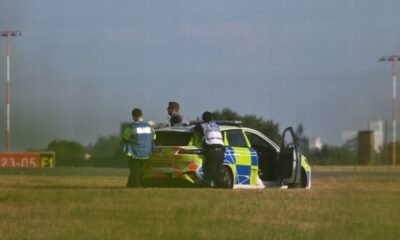
 Europe5 days ago
Europe5 days agoSmall plane crashes at London Southend Airport
-

 Europe3 days ago
Europe3 days agoAmerican accused in murders of mother and baby appears before Italian judge after extradition
-

 Asia3 days ago
Asia3 days agoThai police arrest woman who allegedly seduced and blackmailed Buddhist monks
-

 Europe3 days ago
Europe3 days agoChina, North Korea and Russia represent biggest security challenge since World War II, Japan says




